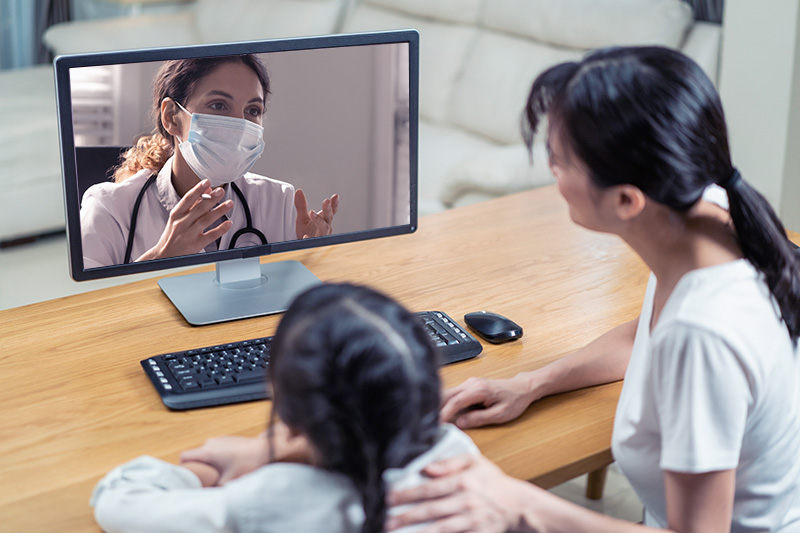(Virtually) visiting the home to help control childhood asthma

Many children have difficulty taking their asthma medicine on a regular basis.
Sometimes it’s a matter of feeling well and deciding not to take the medication; other times, it’s simply forgetting. But some children also don’t know how to properly use an asthma inhaler, or they can’t access their medicine in the first place.
A Boston Children’s research initiative aims to get those children on track. Clinicians from the hospital’s Division of Pulmonary Medicine want to determine if a virtual visit to children at their homes can increase their adherence to asthma medication. They’re hoping to prove that virtual connections emphasizing education can help children get their severe asthma under control.
“When children regularly take their asthma medication, the outcomes are better,” says Tregony Simoneau, MD, a pulmonologist and member of the Severe Asthma Program. “And that’s what’s driving the research: How can we achieve better adherence?”
There’s no place like home
Studies have shown children’s adherence to inhaled asthma medication is 50 percent or even lower — a disconnect that is associated with emergency room (ER) visits and hospitalizations. But when clinicians visit a child’s home to educate them on asthma and also evaluate environmental triggers, asthma impairment decreases by 40 percent, ER visits drop by more than 60 percent, and hospitalizations fall by more than 80 percent, according to previous research by Boston Children’s.
Despite the success of in-home visits, pulmonary clinicians can’t reach every patient because of geographic and cost barriers. But a reliance on virtual appointments during the COVID-19 pandemic opened another window into the homes of children treated by the Severe Asthma Program, allowing Simoneau and colleagues to see their patients in action and collect accurate data about adherence.
“We could see their medications, and if they were empty,” Simoneau says. “We saw how they used their inhalers and the environments they’re living in. We got much more information by virtually going into their homes.” That prompted her and Jonathan Gaffin, MD, MMsc, director of the Severe Asthma Program, to start a virtual visit research project last year. At least 30 patients will participate.
When children regularly take asthma medication, outcomes are better.
Tracking the use of medication
During a regular checkup at Boston Children’s, a child participating in the study will complete an asthma control test (ACT). It’s a series of questions to determine how often they had shortness of breath and whether symptoms affected them at home, school, or work. Their baseline asthma medication adherence will also be measured by self-reporting and a standardized survey.
Then, within the next six months, a nurse and pulmonologist, or another specialist from the Severe Asthma Program, will visit the patient virtually. The patient will again complete an ACT and also recall how often they took their preventative asthma inhaler or nebulized medication in the past 14 days. When a participant returns to Boston Children’s six months later for a follow-up exam, they will again take an ACT. A clinician will also record how often a patient’s severe asthma exacerbations required steroid treatment or even hospitalization six months before and six months after the virtual visit.
Because children and their families might not accurately recall medication use, the study will also measure pharmacy refill data. This could be a key finding because some families have difficulty paying for medication or don’t have immediate access to a pharmacy.
Keeping asthma in check
Just as importantly, the virtual visits will let Simoneau and her colleagues observe how a patient uses an inhaler or nebulizer, enabling them to demonstrate best practices and offer advice on how to stick to a regular schedule. They will also virtually explore a patient’s home environment, looking for allergens that might trigger asthma. Funding by Harvard’s Office of Faculty Development and Diversity supports the purchase of vacuum cleaners, air purifiers, mattress covers and pillowcases, and other items that can lessen asthma symptoms.
Simoneau has high hopes the study will validate that virtual visits can improve how children take their medication and keep their chronic condition in check. Ideally, she says, virtual visits would become a permanent part of care not just for her program but for other hospitals and practices that treat asthma.
“I am often impressed by what we see in the home and how hard families are working to try to help their children,” she says. “These visits can help make sure they are directing their efforts toward evidence-based interventions.”
Learn more about the Severe Asthma Program.
Related Posts :
-

Addressing inequities in asthma by focusing on children’s environments
Asthma strikes children in low-income urban areas especially hard, more often sending them to the hospital. For more than 20 years, ...
-

Trial for severe asthma targets a mutation common in children of color
Children and adults of color have higher rates of asthma than white people, as well as more hospitalizations and deaths. ...
-

SMART: A new approach to asthma management
Until recently, the typical approach to asthma involved two inhalers. In its first update since 2007, the National Asthma Education and ...
-

Asthma, softball, and COVID-19: Gwen’s story
Gwendolyn Castro has a competitive streak. Whether playing softball or debating topics like universal health care, the 15-year-old wants to ...





